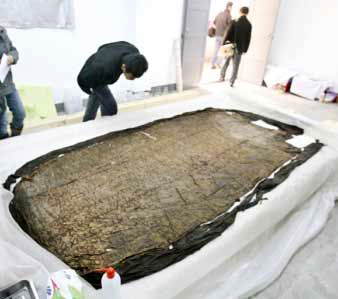On December 6 over 200 bamboo slips inscribed with ancient Chinese characters were discovered packed in a silk bag tucked into the Xiejiaqiao No.1 tomb in Hubei Province. The tomb is over 2,200 years old.
The ancient documents were found nine days after archaeologists uncovered a 2.46-meter-long coffin wrapped in four tiers of embroidered silks. Amazingly, the shroud has remained intact underground after thousands of years.
"Tombs from the Han Dynasty have been found in many places across the country, but it is rare to find such a well-preserved one. This will provide valuable historical data for studies in archaeology, history, zoology, botany and historical textile science," said Wang Mingqin, head of Jingzhou Museum, at a press conference on Thursday, as reported by the Xinhua News Agency.
The bamboo slips revealed the identity of the tomb owner. She was an aristocratic woman named "Hui" who lived during the Han Dynasty (206 BC - AD 220).
According to the documents, the woman was the mother of four officials of noble rank. She was buried on November 28, 183BC. Archaeologists found an intact skeleton inside the coffin. The coffin itself was decorated with woodcarvings that still remained discernible after thousands years of humidity and erosion.
About 200 cultural relics were also unearthed in the four coffin chambers. Items included bronze ware, lacquer work, wood and pottery, according to a statement by the Xinhua News Agency on December 6.
Archaeologists opened the coffin on November 29. It was filled with black liquid and spotted with white maggot shells. Archeological cleaning procedures are expected to last for more than two months. Investigations into the bamboo slips and the cause of death are continuing.
(China.org.cn by Wu Jin, December 7, 2007)


